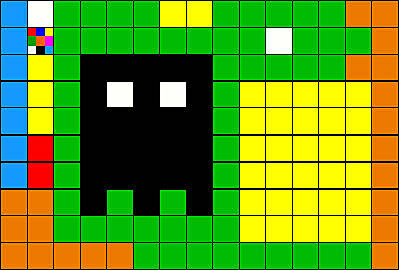
Screening Circle, a work of net art by artist Andy Deck, was inspired by the tradition of the quilting circle: a group of people who make a quilt together, each producing small squares that are later sewn together. Screening Circle reinterprets this popular craft tradition in the context of interactive electronic art, using the WWW as its medium As you draw in this circle you may notice icons changing, because other people are drawing at the same time. The title refers to the screen because it is not a material product that people are making with this tool-like artwork. The products are composed of flickering light that can be “screened” in a variety of ways. The work was commissioned by the Whitney Museum’s Artport and can be accessed here.
 Screenshot of Screening Circle project site at Deck’s website, Artcontext.net.
Screenshot of Screening Circle project site at Deck’s website, Artcontext.net.
According to the Whitney Museum,
Visitors to the site can enter the drawing area to compose loops of graphics and affect and edit each other’s screens. The pieces can be made by one person or by several people and the arrangement of the segments can be haphazard or precise. In the screening area, the resulting motion graphics will be on view instantaneously. The “circle” invoked in the title refers to the circle of participants, and, indirectly, to the loop of images that are produced. “Screening” refers to the pre-viewing of film in the film making process. It is a form of viewing that allows people to have some influence over the final product.
Screening Circle is uncensored, except in so far as the graphics are low-resolution by design. How low-resolution must a picture be before it is inoffensive? Uncopyrightable? How high-resolution must graphics be before they are expressive and valuable to protect as “free speech”?
Other works by Andy Deck include Glyphiti, another work of net art in which the audience become active participators in the creation of a collective, mutable image.

<http://www.tate.org.uk/intermediaart/entry15483.shtm>
Andy Deck, artist’s website: http://www.artcontext.net/
